Schmidt: A museum is also a business. We must enhance art as we do soccer
“If we valued art like we do soccer, we could produce 2-3 billion as well.” This was said by the director of the Uffizi, Eike D. Schmidt, interviewed a short while ago by Nicola Porro on the program Fourth Republic on Rete 4. “The abundance of beauty that there is in Italy,” Schmidt said, “often leads to the mentality of saying that people come anyway and we don’t have to put effort into it. Other countries that have very little compared to Italy, on the other hand, really have to make an effort.”
During the interview, Schmidt also talked about how foreign directors find themselves having to manage Italian museums. “We are a few Germans, one Canadian, two French ... but actually most of them are Italian directors, but they often come from other realities, there are Italians who have a background in management, there are Italians who have been a few years abroad and have known from the inside realities that are managed in a more entrepreneurial way than traditional statism,” said the Uffizi director. “I am German but I am married to an Italian of partly Florentine, partly Romagna and partly Lombard origins. I am from Freiburg, from southern Germany, I am a southerner-a German terrone. Every day we try to deal with the bureaucratic machine, you have to understand it but up to a certain point, so that we can work with this bureaucracy but never internalize it, otherwise we become part of the problem. Even in Germany there is a strong bureaucracy, but the strongest bureaucracy I experienced in my professional life was in California,” Schmidt revealed.
According to the Uffizi director, “a museum is also a business, and just as it is sometimes useful to have someone at the head of a company who is an engineer who knows very well how products work, so it is good to have an art historian, an archaeologist or a museologist at the head of the museum, but an entrepreneurial or numerical knowledge approach is also important. That helps us a lot.” As for the numbers, Schmidt said, "in 2019 we had a turnover of 34 million, when I arrived it was 18 million, however, there is still potential. It doesn’t just depend on how many people come into the museum. It depends on targeted discounts, it depends on other products, for example there are transfers of artworks also abroad, and there is a whole series of revenue streams that are now starting to be explored."
So for Schmidt, it is also possible to monetize the loans of works, although there are some masterpieces, those that are part of the museum’s identity, that are immovable. “What we see now,” Schmidt comments as images of works such as Botticelli’s Venus, Parmigianino ’s Madonna with the Long Neck, and Caravaggio’s Bacchus flow on television, "are all absolute masterpieces that it makes no sense to send elsewhere, not only because they are extremely fragile, but also because someone coming from Japan, England, or South America, perhaps on their honeymoon, and not seeing these works, then they would not only demand a refund of the ticket price, but ... of the entire trip. However, there are so many works in storage, thousands of works that need to be enhanced. This is one of the inspirations of the Uffizi Diffusi project: to take the works to the various locations in Tuscany and beyond to show them, to bring them close to where people live, but also where people can go on vacation, perhaps admiring the beauty of nature, the gastronomic beauty and the artistic beauty all together."
 |
| Schmidt: A museum is also a business. We must enhance art as we do soccer |
Warning: the translation into English of the original Italian article was created using automatic tools. We undertake to review all articles, but we do not guarantee the total absence of inaccuracies in the translation due to the program. You can find the original by clicking on the ITA button. If you find any mistake,please contact us.





























